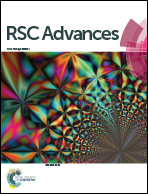A facile, green, and solvent-free route to nitrogen–sulfur-codoped fluorescent carbon nanoparticles for cellular imaging†
Abstract
A simple, green, and solvent-free method was developed for large-scale preparation of fluorescent nitrogen–sulfur-codoped carbon nanoparticles (NSCPs) by direct thermal treatment of gentamycin sulfate at 200 °C. The as-prepared NSCPs displayed high water-solubility, long lifetime (14.01 ns), high quantum yield (27.2%), excellent stability, and low cytotoxicity, and can be used as a probe for cellular imaging.


 Please wait while we load your content...
Please wait while we load your content...